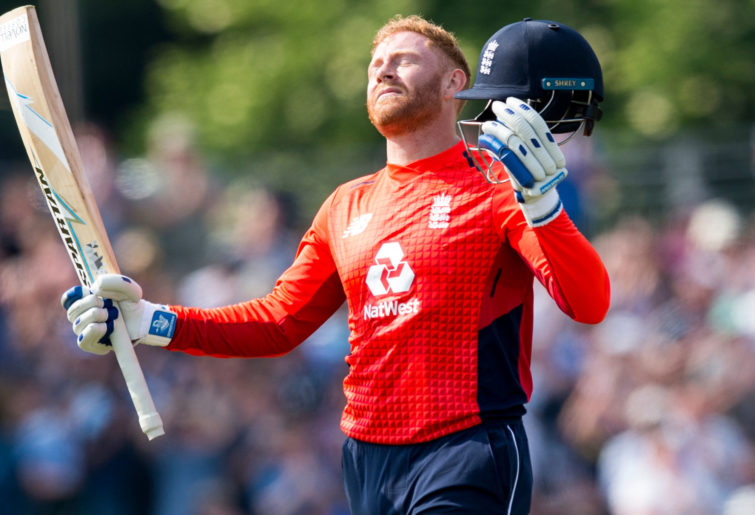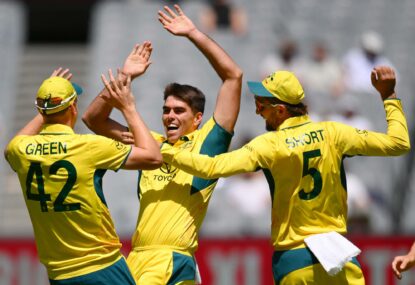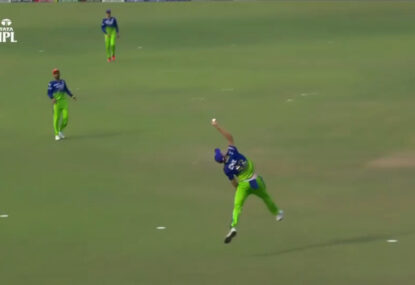After Australia had cunningly lost to South Africa in the final group match to avoid the rampant New Zealand cricketing machine in the first semi-final, they instead headed to Edgbaston to take on England in the second.
Here are the ratings for the semi-final between Australia and England.
Replacements
Grade: B+
Australia won the toss and elected to bat. Handscomb was the new man in the team, chosen to play because he was in the squad replacing Shaun Marsh, who would have been the man to replace Usman Khawaja when Khawaja was injured in the previous game, had Marsh not already been injured in the nets prior to that game.
The man who did replace Khawaja in the squad, Matthew Wade, had not been chosen to replace Khawaja in the team, although there had been talk that Wade might replace Glenn Maxwell in the team, even though the injury to Maxwell in that same net session that had led to Marsh being replaced by Handscomb had not been serious enough for Maxwell to be replaced in the squad, and the prospect of Maxwell being replaced was due more to form than fitness, and even then, not, as Maxwell ultimately retained his spot ahead of Wade.
It was all very simple, and by the time everybody had wrapped their heads around it, Aaron Finch, David Warner and Handscomb himself were all out as Australia slumped to 3/14 in the face of a blistering opening bowling spell from Chris Woakes and Jofra Archer.

Australian batsman Aaron Finch. (AP Photo/Tsvangirayi Mukwazhi)
Steve Smith
Grade: B+
Khawaja’s absence also allowed Steve Smith to move up one batting spot to three. This was a tremendous advantage for Australia, allowing their fidget rate to increase significantly.
Khawaja, while solid, is not a particularly restless batsman. So having Smith in and being idiosyncratic early was a massive plus. TwitchViz analysis suggested that Australia’s Fidget Index was a staggering 9.4 after just ten overs of batting, peaking at 15.6 a little later as Smith looked to hold the innings together.
Less importantly, Smith also made 85 runs before being run out in the 48th over.
Alex Carey’s face
Grade: A-
The batsman who spent the most time in the middle with Smith was wicket-keeper Alex Carey, promoted to five as reward for his excellent batting throughout the tournament.
Carey once again showed great composure and skill in his knock, a cool head gathering runs carefully before he fell as the fourth wicket. Carey also showed great composure and skill when he was knocked in the head, gathering his helmet carefully before it fell forth onto his wicket.
A man of many skills is Carey, but it was the latter moment where a short ball from Archer knocked his helmet off and cut his chin that had people talking.
A hasty repair job meant that Carey’s face was held together with bandaging leading from his chin up and under his helmet. It was a look reminiscent of Rick McCosker in the Centenary Test, and the surest possible omen that Australia would win the match by 45 runs.
It was also a pretty clear challenge to England’s wicket-keeper Jos Buttler. Carey’s facewear now meant that if Buttler came out to bat in anything less than a full Point Break-style Richard Nixon mask, it would be a significant moral victory for the Australians.
Alas, Buttler never got the chance to bat, so we were denied the opportunity to know for sure. Ah well, next World Cup.
Jonny Bairstow and Jason Roy
Grade: A-
After Carey’s dismissal for 46, Australia lost steady wickets to be 7/166 in the 38th over. All part of Australia’s master plan to get Mitchell Starc in with time to bat. After all, Starc was the man who knew better than anyone else what he could singlehandedly defend.
In the end, Starc looked at Australia’s total of 213 from the last World Cup semi-final they played in England, sensibly added ten more runs as a buffer and set England 224 to win.
Jonny Bairstow and Jason Roy set off in pursuit of this total, scoring 124 runs for the first wicket in just 17.2 overs to more or less end the contest. Indeed, as Roy hammered Smith for three sixes in his sole over, the England worm became almost fully erect.

Jonny Bairstow, (Photo by MB Media/Getty Images)
So confident were England by that stage that Bairstow decided the rest of the batsmen could finish the match off without the assistance of DRS. He therefore sent a perfectly valid LBW upstairs and departed the middle with 34 runs and his team’s sole review. A massive statement of intent from Bairstow.
Also, a rude shock to Jason Roy, who was ‘caught’ behind shortly after, tried to review it, only to be told that he couldn’t. He then stood his ground and argued with the umpires for a bit before being furiously escorted from the centre.
A classic show of dissent from Roy that cost him 30 per cent of his match fee and two demerit points. Over to the ECB now to step up and impose a one-year ban.
England Winning
Grade: D
Roy’s bizarre dismissal and response to it ultimately mattered not one iota. Eoin Morgan and Joe Root saw England safely home with eight wickets in hand and, uh, eighteen overs to spare.
If England are going to comically crash out of this World Cup and leave all their fans devastated, they’re leaving it awfully late.
But if they do somehow win the World Cup, won’t it, in many ways, be a hollow victory? Isn’t spending four years deliberately building the best one day batting side in the game’s history specifically to target this exact tournament tantamount to some kind of cheating?
I think it probably is, which means that the final is now a classic New Zealand vs Evil battle. In many ways, I hope the Black Caps win, mostly because after they knocked India out of this World Cup, they’re highly unlikely to be invited back to the 2023 version.






































































































